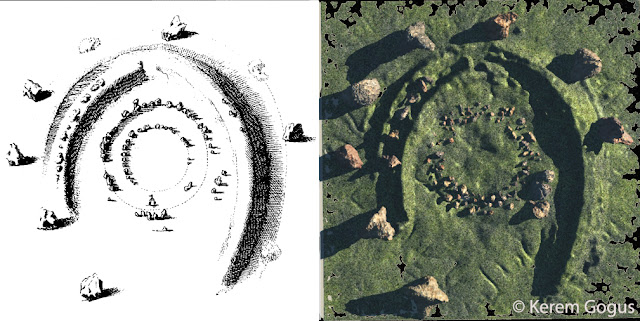
The huge monoliths of Ireland's Stonehenge were buried
Monument was thought to have been completely destroyed some time between 1748 and 1907
However, some of its largest stones might have been buried
For years I have been drawing attention to a monument, sadly destroyed, which has been dubbed 'Ireland's Stonehenge'. This was a remarkable and unique monument consisting of several concentric circles of stone, surrounded by a large earthen embankment, all of which was encompassed by ten enormous monoliths.
Ireland's Stonehenge was documented by antiquarian and astronomer Thomas Wright in 1748. His drawing is the only known representation of this once great monument, which was located in a townland known today as Carn Beg, not far from the town of Dundalk, in the north of County Louth. I first wrote about Ireland's Stonehenge in 'Island of the Setting Sun' in 2006.
 |
| A 3D recreation of the stonehenge (right) by Kerem Gogus. |
| Wright's all-too-brief description of this remarkable monument, from Louthiana. |
 |
| A crop mark of the monument on a CUCAP photo from 1970. |
It wasn't until 1988 that the exact location of Wright's druidic temple was finally rediscovered. Archaeologist Victor Buckley was able to discern the monument's "footprint" in an aerial photograph which had been taken in 1970 for the Cambridge University Collection of Aerial Photographs.
There was some archaeological resistivity was carried out at the site in 2006, in advance of a proposed housing development which never happened once the Irish economy collapsed. Standing at the site, which is now part of a disused golf course attached to a hotel, it is very difficult to get any sense that it was anything other than a field. There are simply no stones remaining. None.
However, I've recently discovered something significant about what might have happened to the large stones - or at least some of them - in the most unlikely of sources.
Reading George Henry Bassett's 'Louth County Guide and Directory (1886), we find that early on, he makes reference to the area's antiquities:
The remains of antiquity are very numerous, and extend through every part of the county. They continue in very much the same condition that they were found more than one hundred and twenty-five years ago by Thomas Wright, author of Louthiana. His work was instrumental in stimulating the curiosity of many of the residents of the county in regard to the precise nature of the contents of the Danish and Irish forts and Druidical camps.
 |
| In this work in progress, digital artist Kerem Gogus has fantastically recreated Ireland's Stonehenge in 3D based on Thomas Wright's 1748 drawing. |
It had not the effect, however, of preventing a tenant, near Dundalk. from effacing the Druidical circle at Ballynahatna. Of the ten stones which were said to represent the generations from Adam to Noah, only one now stands in the original position. Most of the rest were dropped into holes sunk behind them, and covered at a sufficient depth to escape the plough.This is most interesting. Bassett says that instead of bring broken up, like the smaller stones, the large ones were dropped into huge holes to bury them. This is quite exciting as it leads to the possibility that at least some of these large megaliths are still there - buried where they once stood. Perhaps this is information which might lead archaeologists towards further investigation of the site at Carnbeg?
Further reading: Ireland's Stonehenge
Note: I am indebted to Kerem Gogus, the 3D artist, for all the effort he put in to recreating Ireland's Stonehenge so that we might get a better sense of what it looked like. Visit his website here:
http://keremgogus.com/
